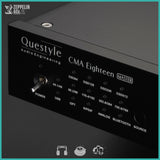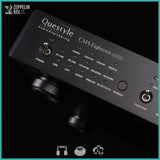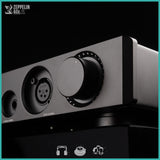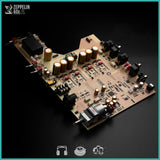In a throwback to Hi-Fi luminary Dan D'Agostino's work [using Texas Instruments] for Krell Industries at the beginning of the 21st century, Questyle designed CMA18's analog circuit path to operate transmitting signal solely in current instead of the standard voltage, starting from its ES9039Pro's analog current output.
Manufacturers have long taken advantage of the ESS flagship's claim to be the most sophisticated DAC chip available, outputting in current for best distortion figures before traditionally voicing the circuit through the crucial I/V current-to-voltage converter stage.
But D'Agostino understood then that no I/V stage could completely disappear sonically, colouring the sound artificially in ways unacceptable – he therefore removed the stage entirely, by employing Krell's own current-mode analog circuit. Transmission of signal, entirely in current, without prior conversion to voltage, has been revived by Questyle to the same effect here.
Removal of the I/V aspect of CMA18's circuit therefore sees the purest expression ever of Questyle's current-mode philosophy, keeping affairs post-digital conversion magnificently and elegantly simple with fewer parts necessary.
Questyle's choice of current-mode signal is the stuff of legend by now. It eliminates the lag time that might otherwise occur when signal is transmitted in voltage, as it builds up at the capacitances in the circuit – current signal passes through unhindered by comparison, with speed and ease.
By doing away with the issue of transmission delay in CMA18, Questyle virtually eliminates any of the harshness caused by the intermodulation distortion associated with high capacitance, solid-state circuits.
Coloured yet correct, CMA18 presents detail smoothly and organically with a sense of vibrancy that's accurate and still entertaining. Another effect of being unhindered by capacitance in the signal path means that huge signal bandwidth is possible, leading to phase response being accurately preserved in the human hearing range.
Indeed, to hear current-mode is to hear a naturalness to music not encountered before in a conventional circuit, and Questyle build CMA18 as the ultimate expression to such a topology.
It's an implementation that certainly flatters the ES9039Pro – a chip that packs enough computational horsepower to run its 8x oversampling process in just two passes thus minimising rounding errors – an upgrade on its predecessor that used a concatenation of three stacked 2x oversampling passes which compound errors.
Not merely an advertisement for Questyle, but for ESS, the ES9039Pro's patented Hyperstream pulse-width modulation technology is a one-up on standard delta-sigma modulation. It now enters its fourth iteration pushing nigh inaudible high-order distortion levels post-conversion further down.
This futuristic quad-mono ES9039Pro imparts a digital filter with extremely low in-band ripple and top noise and distortion rejection to allow CMA18 impart a new realism to your music.
A 4.4mm headphone output, a pure Class A small signal and power stage, and LDAC Bluetooth input, then allows users to enjoy Questyle's flagship in ever more scenarios. Current-mode will prove even more effective the closer a load is to ground. The results translate to an ultra-low distortion, linear, analog system in tandem with Class A, without resorting to the excessive use of negative feedback.
CMA18 works as a perfect DAC for your Hi-Fi system into component input impedances that have been dropping ever more readily since the turn of this decade. Flip CMA18 to variable volume mode, and its analog potentiometer turns it into an excellent pre-amp.
Everything above discusses the less-obvious about a true Questyle flagship, because the plain truth is that CMA18 functions as the perfect headphone amplifier first and Hi-Fi hub second. Check out Questyle's other headphone specialties here, or view our other DACs here.







